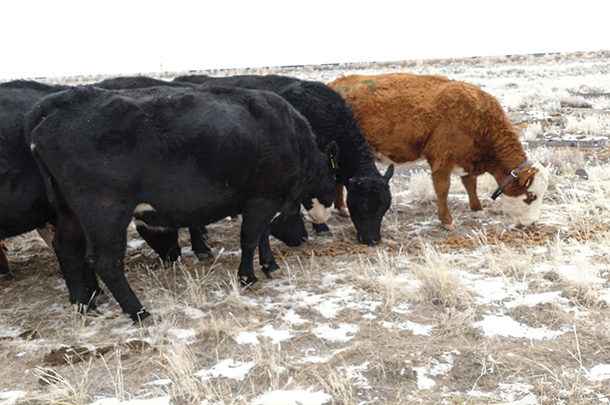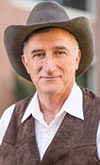Usually, the cheapest form of energy one can provide range cows during late fall is native rangeland that has been rested for the entire growing season.
Unfortunately, although an adequate quantity of forage may be available with dormant season grazing, the forage quality will be lacking nutrients (Figure 1).
Without any intervention, animal performance and overall ranch profitability can be impacted. Older cows will typically lose about 0.9 pounds per day and younger cows will lose about 1.8 pounds per day on dormant rangeland forage, if they are not provided any protein supplement.
However, with a modest input of protein supplement (1 pound per day for each cow fed once a week; 7 pounds per weekly feeding at mid-day), producers can capitalize on improving animal performance and encourage cattle to use rangeland more efficiently.
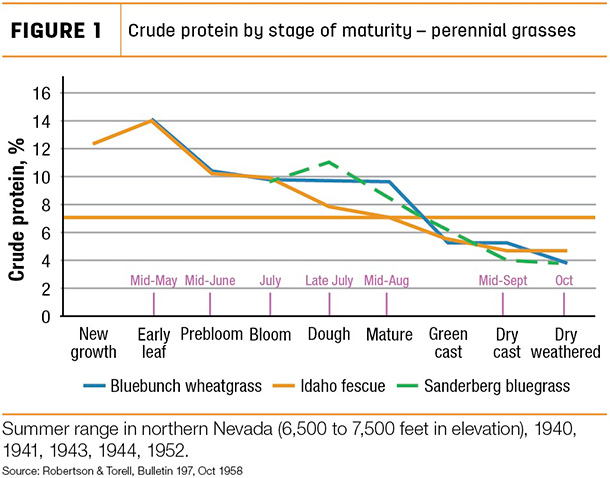
Supplemented cattle will typically gain more weight than non-supplemented cattle, better enabling them to maintain body condition prior to calving (Figure 2: University of Idaho 45-day supplementation trial).
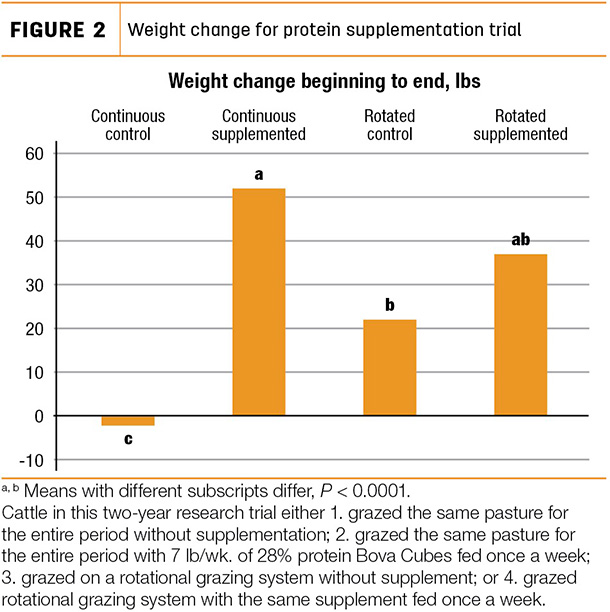
Cattle provided an opportunity to rotate into a fresh pasture (without any supplement) will also have greater performance than non-supplemented cows that stay in the same pasture without the benefit of pasture rotation.
Common cow grazing behavior
During dormant season grazing, cows can be expected to increase their harvesting rate (bite rate) as days get shorter and colder. A study conducted in 2015 by the University of Idaho on late season rangeland with 2-year-old non-supplemented cows found that cows increased their harvest rate from 55 bites per minute on Nov. 21 to 85 bites per minute on Dec. 8 as temperatures declined.
Increasing the harvest rate of forage is a strategy cows use to better approximate and approach animal maintenance requirements via increased forage intake. However, if crude protein in the forage is below 7% (which it often is with dormant cool-season grasses), cattle may spend more time futilely searching for better-quality forage instead of efficiently harvesting forage.
Changing cow grazing behavior
In the two-year research trial conducted by the University of Idaho in Dubois, Idaho, we collared a subset of 24 2-year-old cows every year to observe grazing behavior. The collars contained both a GPS logger and an accelerometer. An accelerometer is used on rockets to measure velocity in three directions. It is also the device that switches the screen orientation when a smartphone is rotated. By pairing observed cow grazing behavior with accelerometer readings, we were able to determine daily grazing (head down and eating), resting (head idle) and walking (head bobbing side to side) activity on a 24-hour basis.
GPS locations were recorded every two minutes and accelerometer readings were obtained 25 times per second and averaged five-second intervals. We call this rocket science on the range.
The supplemented cows we collared in this trial grazed forage more efficiently than did non-supplemented cows. Cows in the continuously grazed, protein-supplemented pasture spent more time resting (up to one hour more per day) and less time futilely searching for better quality forage than did control (unsupplemented) cattle grazed in the same pasture (Figure 3), thus expending less energy to graze.
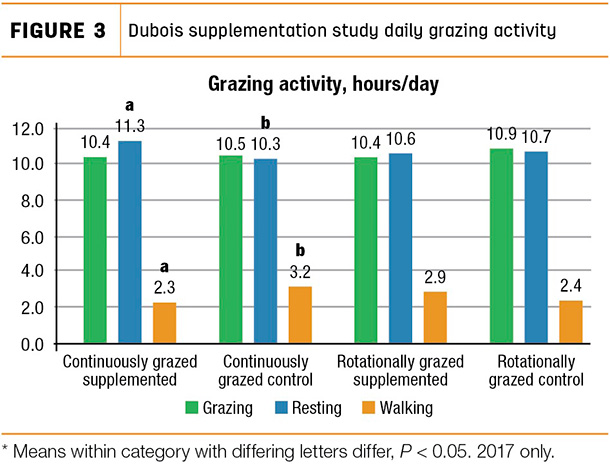
When daily walking time was evaluated (Figure 4), it was apparent that cattle that stayed in the same pasture without any supplement were much more restless, walking about the same amount of time every hour (7.5 minutes).
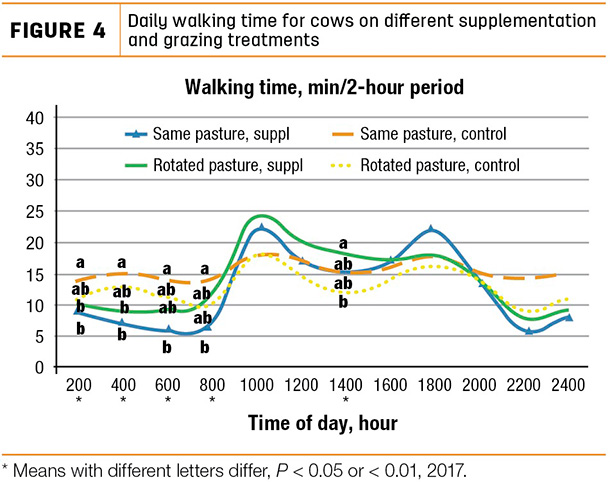
In contrast, supplemented cattle and cattle that had the opportunity to rotate pastures walked less during idle early morning and late evening hours and increased walking during morning and evening grazing bouts. Cattle that stayed in the same pasture with no supplement were constantly searching for a better-quality diet that was not readily available.
All supplemented cattle increased their harvest rate (Figure 5) over non-supplemented cattle, enabling supplemented cows to gain more weight (see Figure 2).
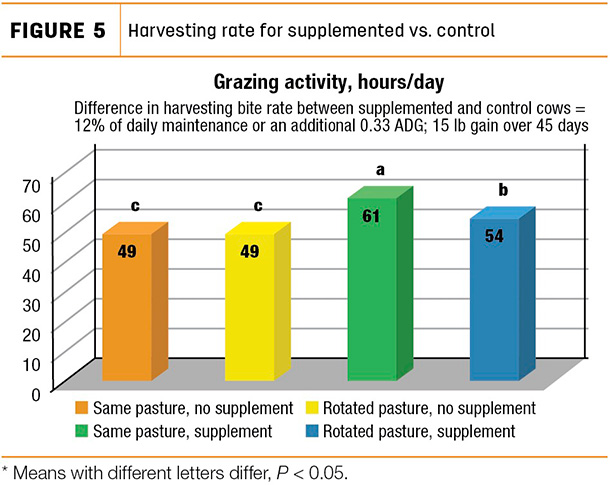 Additionally, supplemented protein feeds rumen microbes, thus increasing both the digestibility of forage and the passage rate of forage through the rumen. The increased passage rate allows for increased intake of dormant forage, allowing cows to meet maintenance requirements more efficiently.
Additionally, supplemented protein feeds rumen microbes, thus increasing both the digestibility of forage and the passage rate of forage through the rumen. The increased passage rate allows for increased intake of dormant forage, allowing cows to meet maintenance requirements more efficiently.
Conclusions
Minimal protein supplementation for cattle grazing on dormant rangeland pastures goes a long way toward minimizing weight loss or weight gain as cows transition toward calving. Additionally, cattle behavior can be manipulated to graze late-season rangeland pastures more efficiently through the use of protein supplementation. When this study was conducted in 2016-17, the cost of the supplement was $14 per cow, plus labor and gas for distributing the supplement. The expense to replenish weight loss prior to calving for cows grazing late-season dormant forage can easily cost two to three times as much as strategic protein supplementation.
Other cooperators in this research included Joseph Sagers, John Hall, Melinda Ellison and Joel Yelich (all from the University of Idaho) and Bret Taylor (USDA, U.S. Sheep Experiment Station, Dubois), Jameson Brennan (South Dakota State University) and Jim Lamb (Furst-McNess Company, Rexburg, ID).
